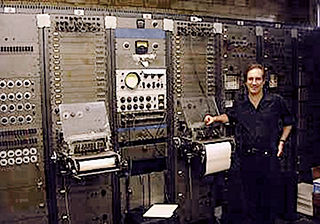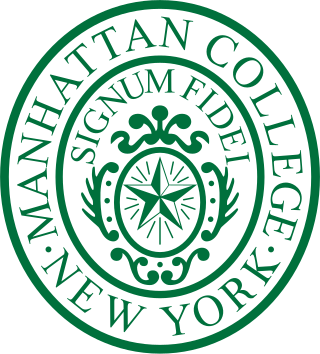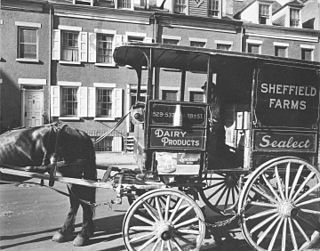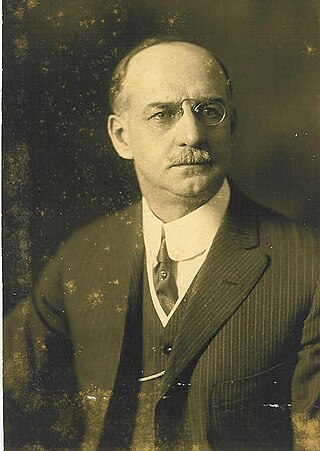The RCA Corporation was a major American electronics company, which was founded in 1919 as the Radio Corporation of America. It was initially a patent trust owned by General Electric (GE), Westinghouse, AT&T Corporation and United Fruit Company. In 1932, RCA became an independent company after the partners were required to divest their ownership as part of the settlement of a government antitrust suit.
The Computer Music Center (CMC) at Columbia University is the oldest center for electronic and computer music research in the United States. It was founded in the 1950s as the Columbia-Princeton Electronic Music Center.

The RCA Mark II Sound Synthesizer was the first programmable electronic synthesizer and the flagship piece of equipment at the Columbia-Princeton Electronic Music Center. Designed by Herbert Belar and Harry Olson at RCA, with contributions by Vladimir Ussachevsky and Peter Mauzey, it was installed at Columbia University in 1957. Consisting of a room-sized array of interconnected sound synthesis components, the Mark II gave the user more flexibility and had twice the number of tone oscillators as its predecessor, the Mark I. The synthesizer was funded by a large grant from the Rockefeller Foundation.

Manhattanville College is a private university in Purchase, New York. Founded in 1841 at 412 Houston Street in Lower Manhattan, the college was initially known as Academy of the Sacred Heart, then after 1847 as Manhattanville College of the Sacred Heart. In 1917, the academy received a charter from the Regents of the State of New York to raise the school officially to a collegiate level granting degrees as the College of the Sacred Heart. In 1952 it moved to its current location in the hamlet of Purchase, New York, a suburb north of New York City. Purchase is inside the town and village of Harrison in Westchester County.

The Fu Foundation School of Engineering and Applied Science is the engineering and applied science school of Columbia University. It was founded as the School of Mines in 1863 and then the School of Mines, Engineering and Chemistry before becoming the School of Engineering and Applied Science. On October 1, 1997, the school was renamed in honor of Chinese businessman Z.Y. Fu, who had donated $26 million to the school.

Manhattan College is a private, Catholic, liberal arts university in the Bronx, New York City. Originally established in 1853 by the Brothers of the Christian Schools as an academy for day students, it was later incorporated as an institution of higher education through a charter granted by the New York State Board of Regents. In 1922, it moved from Manhattan to the Riverdale section of the Bronx, roughly 6.4 miles (10.3 km) north of its original location on 131st Street in Manhattanville.

The Missouri State Capitol is the home of the Missouri General Assembly and the executive branch of government of the U.S. state of Missouri. Located in Jefferson City at 201 West Capitol Avenue, it is the third capitol to be built in the city. The domed building, designed by the New York City architectural firm of Tracy and Swartwout, was completed in 1917.

Manhattanville is a neighborhood in the New York City borough of Manhattan bordered on the north by 135th Street; on the south by 122nd and 125th Streets; on the west by Hudson River; and on the east by Adam Clayton Powell Jr. Boulevard and the campus of City College.

Hamilton Hall is an academic building on the Morningside Heights campus of Columbia University on College Walk at 1130 Amsterdam Avenue in Manhattan, New York City, serving as the home of Columbia College. It was built in 1905–1907 and was designed by McKim, Mead & White in the Neoclassical style; the building was part of the firm's original master plan for the campus. The building was the gift of the John Stewart Kennedy, a former trustee of Columbia College, and is named after Alexander Hamilton, who attended King's College, Columbia's original name. A statue of Hamilton by William Ordway Partridge stands outside the building entrance. Hamilton Hall is the location of the Columbia College administrative offices.

Havemeyer Hall is a historic academic building located in Columbia University in New York City.
This is an incomplete list of historic properties and districts at United States colleges and universities that are listed on the National Register of Historic Places (NRHP). This includes National Historic Landmarks (NHLs) and other National Register of Historic Places listings. It includes listings at current and former educational institutions.

Dungworth is a hamlet in the civil parish of Bradfield, west of Sheffield in South Yorkshire, England.

The Sheffield Farms–Slawson–Decker Company, known as Sheffield Farms, was a dairy that pasteurized, bottled, and delivered milk in New York City in the first half of the 20th century. It became one of the largest dairy companies in the world, selling 20% of the city's milk. The company played a major part in transforming commercial milk into a clean and healthy product.

The Church of St. Joseph of the Holy Family is a Black Catholic parish church of the Roman Catholic Archdiocese of New York, located at 401 West 125th Street at Morningside Avenue in the Harlem neighborhood of Manhattan, New York City. It is the oldest existing church in Harlem and above 44th Street in Manhattan. On June 28, 2016, it was designated a New York City Landmark.

Sheffield Farms Stable was a historic stable located in Manhattanville, New York, New York. Designed by Frank A. Rooke, it was a six-story, light colored brick building with terracotta ornament. It was originally built in 1903 as a two-story stable building for the Sheffield Farms dairy, then expanded to its present size in 1909. It housed horses used for the delivery of pasteurized milk until July 1938. It was sold in 1942, after which it housed a real estate company, insurance company, and warehouse.

Briarcliff Farms was a farm established in 1890 by Walter William Law in Briarcliff Manor, a village in Westchester County, New York. One of several enterprises established by Law at the turn of the 20th century, the farm was known for its milk, butter, and cream and also produced other dairy products, American Beauty roses, bottled water, and print media. At its height, the farm was one of the largest dairy operations in the Northeastern United States, operating about 8,000 acres (10 sq mi) with over 1,000 Jersey cattle. In 1907, the farm moved to Pine Plains in New York's Dutchess County, and it was purchased by New York banker Oakleigh Thorne in 1918, who developed it into an Aberdeen Angus cattle farm. After Thorne's death in 1948, the farm changed hands several times; in 1968 it became Stockbriar Farm, a beef feeding operation. Stockbriar sold the farmland to its current owners in 1979.

The Studebaker Building is located at 615 West 131st Street, between Broadway and 12th Avenue, and between 131st and 132nd Streets, in the Manhattanville section of the Upper West Side in New York City. It is in the northeast quadrant of the Manhattanville Campus of Columbia University. It is near the New York City Subway and several local bus routes. It is one of three historic buildings to have survived in the university's Manhattanville expansion, the others being Prentis Hall and the Nash Building.

Frank Aydelott Rooke, known professionally as Frank A. Rooke, was a New York architect who designed the historic Claremont Riding Academy and numerous other structures of significance that are either in National Historic Districts or listed on the National Register of Historic Places in the tri-state area.

Schermerhorn Hall is an academic building on the Morningside Heights campus of Columbia University located at 1190 Amsterdam Avenue, New York City, United States. Schermerhorn was built in 1897 with a $300,000 gift from alumnus and trustee William Colford Schermerhorn. It was designed by McKim, Mead & White, and was originally intended to house the "natural sciences". During the early 20th century, it was used for studying botany, geology, physics, mechanics, and astronomy. The inscription above the doorway reads, "For the advancement of natural science. Speak to the earth and it shall teach thee." Today, Schermerhorn Hall houses the Departments of Art History and Archeology, Earth and Environmental Science, and Psychology.
Edmund Astley Prentis, Jr. was an American engineer and art collector. He was a former president of the American Standards Association.

















